

Les composants d'un repas japonais. A Japanese meal differs slightly from the multiple courses that are traditionally found in Western and European cuisine.
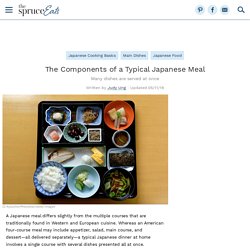
Whereas an American four-course meal may include appetizer, salad, main course, and dessert—all delivered separately—a typical Japanese dinner at home involves a single course with several dishes presented all at once. While many Japanese restaurants in America and Europe feature smaller plates as appetizers separate from the second (main) and third courses, a typical Japanese meal combines all of these courses into one and is considered dinner, or referred to in Japanese as “gohan,” meaning meal or cooked rice.
Following dinner, dessert might be served as the second course. Manger à la japonaise. Japanese people call each meal "gohan.

" For example, breakfast is called "asa-gohan. " A bowl of steamed rice is included in typical Japanese meals and can be part of breakfast, lunch, or dinner. Side dishes are called okazu and are served with rice and soup. Rice is a staple of the Japanese diet. Agedashi Tofu (Japon) Show Full Nutrition LabelHide Full Nutrition Label (Nutrition information is calculated using an ingredient database and should be considered an estimate.)

Agedashi dofu, or agedashi tofu, is a traditional Japanese tofu dish that is a popular appetizer you can find in restaurants. Aubergines au miso. See Full Nutritional GuidelinesHide Full Nutritional Guidelines (Nutrition information is calculated using an ingredient database and should be considered an estimate.)

Nasu-miso is pan-fried eggplant dressed with a savory-sweet miso glaze. A grilled version of this dish is known as Nasu dengaku where the eggplant is grilled with a miso glaze. This recipe for Nasu-miso is simple and easy to prepare, and the taste is simply extraordinary. Banbanji (poulet sésame) Bol de riz japonais aux trois couleurs (Sanshoku Donburi)
Boulettes au poulpe à la japonaise. Takoyaki is a popular Japanese snack food or street food.

It is made with a savory pancake batter, similar to its cousin okonomiyaki (savory pancake with vegetables and/or meat) but shaped into round balls and filled with cooked octopus. While the idea of octopus in a pancake may sound unappealing at first, you'll be surprised at how savory, delicious, and addictive this favorite Japanese snack is! In fact, takoyaki, which is generally eaten as a snack, can be a meal in itself. Restaurants and takoyaki stands tend to sell takoyaki in packs of 8 pieces or 12 pieces, which can be quite filling. The term takoyaki comes from "tako", meaning octopus, and "yaki", which means grilled. Boulettes Teriyaki. Teriyaki meatballs can easily go from a party appetizer to a weeknight meal.

These sweet and spicy orbs are packed with ginger and scallions, then glazed in an easy and simple homemade teriyaki sauce. They're quick to pull together for last-minute entertaining and are packed with umami that'll impress everyone. These meatballs look especially cute when served on little picks for a fun, yet sophisticated hors d'oeuvre. Dress them up with extra crushed red pepper flakes for a stronger kick, or pile on top of rice or noodles with sesame seeds and more scallions to serve as a satisfying lunch or dinner. You can easily freeze the baked meatballs on a sheet pan (just make sure to cool them to room temperature first!) Burger de poulet et enoki sauce teriyaki. Chicken katsu, sauce tonkatsu maison.
Chirashi au crabe. Crevettes panées. See Full Nutritional GuidelinesHide Full Nutritional Guidelines (Nutrition information is calculated using an ingredient database and should be considered an estimate.)
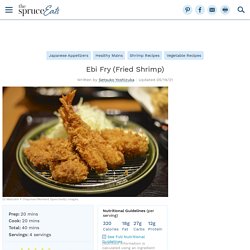
Ebi fry, is a popular Japanese dish of shrimp that is breaded and deep fried and served with tonkatsu sauce or tartar sauce. This dish is commonly made at home, but it is also a classic "yoshoku", or Western, dish that is often found on the menu of Japanese restaurants and cafes. It is also a popular bento lunch item. Curry de viande hachée à la japonaise. Donabe aux fruits de mer. Edamame pimentés. See Full Nutritional GuidelinesHide Full Nutritional Guidelines (Nutrition information is calculated using an ingredient database and should be considered an estimate.)
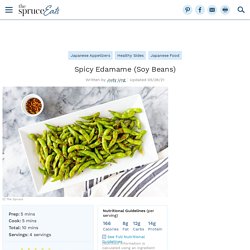
One of the simplest and most popular of Japanese appetizers is edamame, or boiled soy beans. Gyoza au poulet (raviolis japonais) Gyoza aux crevettes. See Full Nutritional GuidelinesHide Full Nutritional Guidelines (Nutrition information is calculated using an ingredient database and should be considered an estimate.)
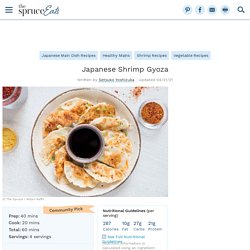
The Japanese gyoza is a close cousin of the Chinese dumpling (jiaozi), although a much more modern invention. It is said that when the Japanese returned home from the occupation of Manchuria during WW II, they recreated the Chinese jiaozi, but made it their own using local ingredients, very thinly chopped, and a thinner wrapper. Gyudon (bol de riz japonais au boeuf) See Full Nutritional GuidelinesHide Full Nutritional Guidelines (Nutrition information is calculated using an ingredient database and should be considered an estimate.)
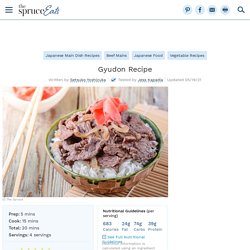
One of the most popular rice bowl dishes in Japan is gyudon -- simmered beef served on top of steamed rice. Haricots tempura à la sauce ponzu. Huile piquante japonaise à l'ail frit. Karaage de poulet. Katsu sando - Sandwich japonais au porc pané. Katsudon : riz au porc frit, oeufs et oignons. Kinoko Gohan (riz aux champignons japonais) See Full Nutritional GuidelinesHide Full Nutritional Guidelines (Nutrition information is calculated using an ingredient database and should be considered an estimate.) Although a variety of mushrooms are available at grocery stores year-round, the mushroom season in Japan is still regaled as a highlight of fall.
To commemorate the fall season, try incorporating a mix of Asian mushrooms into a seasoned rice dish for your next Japanese meal. Kinoko nabe : potée aux champignons japonaise. Kinpira Gobo (racine de bardane à la japonaise) See Full Nutritional GuidelinesHide Full Nutritional Guidelines (Nutrition information is calculated using an ingredient database and should be considered an estimate.)
Kinpira Gobo is a traditional Japanese dish often enjoyed at home, typically served in a bento box. It’s perfect for lunch and busy weekday dinners when you want one more thing for the menu. Kinpira Renkon (racine de lotus à la japonaise) Kinpira renkon is braised lotus root and is part of the Japanese culinary tradition of izakaya, or small plates.
Kinpira is a Japanese cooking style in which sliced vegetables are stir-fried and seasoned with sugar and soy sauce. The most common ingredients used for Kinpira is gobo (burdock root) and carrot, but the lotus root is another common ingredient of this cooking style. The name Kinpira comes from legendary muscleman, and that shows how nutritious the dish really is. Korokke : Croquettes de pomme de terre japonaises au boeuf. See Full Nutritional GuidelinesHide Full Nutritional Guidelines (Nutrition information is calculated using an ingredient database and should be considered an estimate.) Korokke are mashed potato cakes that are coated with panko and deep-fried. Korokke is a food people of all ages love in Japan. With a crispy crust and creamy, savory interior, they are delicious served as a snack, appetizer, or part of a meal.
Kushiyaki de boeuf. See Full Nutritional GuidelinesHide Full Nutritional Guidelines (Nutrition information is calculated using an ingredient database and should be considered an estimate.) In Japanese cuisine, "kushiyaki " refers to all foods that are skewered and grilled. It includes beef, chicken, pork, offal, seafood, and vegetables. While less commonly used, the term "kushiyaki-ya" refers to restaurants that specialize in skewered foods.
Légumes d'été marinés à la japonaise (Agebitashi) Maki piment au saumon et à l'avocat. Maze Gohan : Riz aux edamame. Melon amer à la japonaise. Nikujaga : un ragoût japonais à la viande et aux pommes de terre. Nira tsukune. Nouilles de sarrasin à la japonaise. Nouilles japonaises au saumon teriyaki. Nouilles japonaises sautées façon Wagamama. Oeuf sur bol de riz comme au Japon (Tamago-Kake Gohan) Okaki : Crackers de riz. Omurice : omelette au riz sauté (Japon) Onigiri. Oyakodon : riz au poulet et aux oeufs. Ozoni (Japon) Poêlée de bok choy. Poisson à la japonaise. Poitrine de porc laquée (Buta No Kakuni) Poulet Teriyaki. Pousses de bambou (Takenoko No Nimono) Ragoût de boeuf au dashi. Ramen au poulet. Ramen aux champignons. Saint-Jacques poêlées aux oignons (Japon) Salade de feuilles de céleri et carottes au sésame. Salade de nouilles soba. Salade fraîche de nouilles soba au sésame. Salade Somen.
Sanbaizu Tsukemono (Pickles japonais) Sauce ponzu. Sauce shiso et ume. Sauté de porc, aubergines et poivrons verts sauce miso piquante. Soupe de palourdes à la japonaise. Soupe japonaise aux enoki et shiitake. Soupe Miso. Spicy Tuna Maki. Steak Hibachi (Japon) Tempura Udon. Thon au gingembre (Maguro No Nitsuke) Tonjiru - Soupe miso au porc et légumes. Tonkatsu ramen. Travers de porc laqués au miso et au miel.
Tsukune (Japon) Wonton au boeuf haché. Yakiniku Donburi : Bol de riz au boeuf et légumes. Yakitori de poulet. Cheesecake à la japonaise. Chi Chi Dango. Daigaku Imo : patate douce frite et sucrée à la japonaise. Dorayaki : sandwich de pancakes japonais à la pâte de haricots sucrés. Gâteau au sésame noir. Glace au sésame noir. Glace au thé matcha. Jiggly cake. Mitarashi Kushi Dango. Mizu Yokan (gelée de haricots rouges) Mushipan. Purin (Flan japonais) Zenzaï : soupe sucrée de haricots rouges et mochi grillé, comme au Japon.